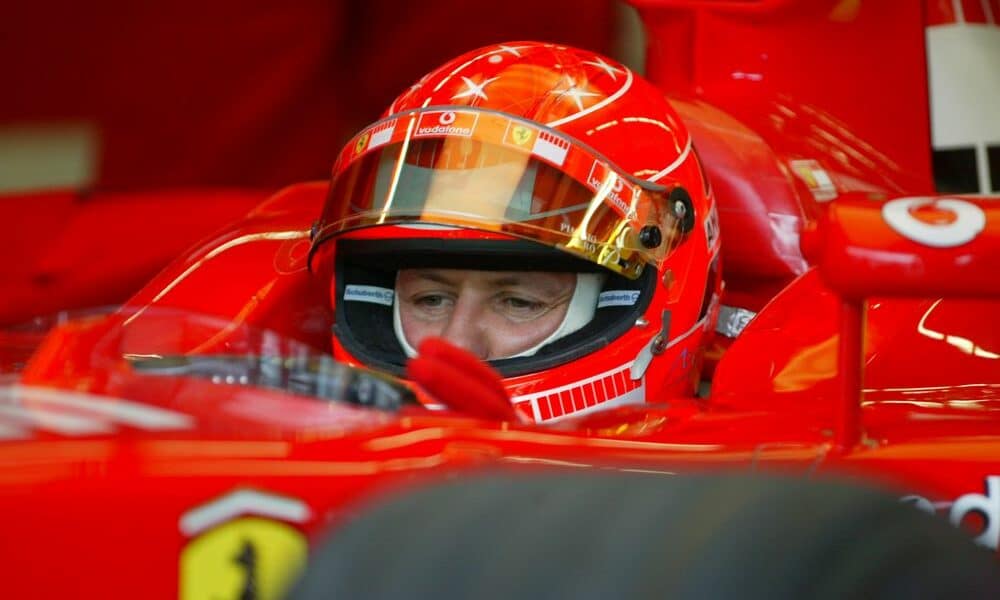At 55 years old, Michael Schumacher, the seven-time Formula 1 world champion, reportedly made his first public appearance in over a decade during the wedding of his daughter Gina-Maria, 27, to Iain Bethke. The event, held in October 2024 at the family’s luxurious villa in Mallorca, Spain, marked a rare moment since the tragic skiing accident that altered the former driver’s life in December 2013. Since then, Schumacher has lived in seclusion at his residence in Gland, Switzerland, under intensive care and far from the spotlight that once defined his illustrious career. His presence at the ceremony, limited to a close-knit group of guests, sparked discussions about his health and the family’s steadfast commitment to privacy. Strict measures, such as banning cell phones, were enforced to shield the former athlete from unwanted exposure.
Organized with utmost discretion, the wedding brought together close friends and family at the Spanish property, a frequent retreat for the Schumachers. The villa, purchased in 2017, features a helipad and enhanced security, facilitating Schumacher’s arrival by helicopter from Switzerland. Reports suggest he did not roam freely in the gardens but remained in a designated area reserved for the most trusted attendees. This meticulous planning underscores the family’s effort to balance protecting the ex-driver with including him in significant moments like his daughter’s wedding. News of the event, widely covered by outlets like the German newspaper Bild, reignited global interest in Schumacher’s condition, a figure who remains one of motorsport’s greatest icons.
Speculation about a potential shift in the family’s approach to Schumacher’s health emerged following the occasion. Corinna Schumacher, who has overseen her husband’s care since the accident, has maintained near-total silence on his condition for over a decade, offering only vague updates on rare occasions. His attendance at the wedding, even in a controlled setting, hints at a subtle change in family dynamics, though privacy remains an unwavering priority. For fans, this moment offers a precious link to the legacy of a champion who once dominated the racetracks and whose life took a dramatic turn due to a single misfortune.
Accident that reshaped a racing legend
The accident that changed Michael Schumacher’s life unfolded on December 29, 2013, in the French Alps at the Méribel ski resort. While skiing with his family, the ex-driver ventured off the marked trails to assist another skier, a choice that led to tragedy. An experienced skier and owner of a property in the region, Schumacher was familiar with the terrain, but a hidden rock altered his fate. His ski collided with the stone, propelling him ten meters forward, where he struck his head on another rock. The impact shattered his helmet in two. Swiftly airlifted to Grenoble Hospital, he underwent two emergency surgeries and was placed in an induced coma due to severe cranial trauma.
After months of hospitalization, signs of consciousness emerged in April 2014, and by June, he was transferred to Lausanne Hospital in Switzerland. Three months later, in September, Schumacher returned to his Gland mansion, retrofitted with cutting-edge medical technology to meet his needs. Millions of dollars were invested to ensure round-the-clock care by a team of specialists, led by Corinna. Since then, the family has chosen near-complete isolation, restricting details about his recovery. In 2014, former driver and close friend Philippe Streiff noted that Schumacher was in a wheelchair, struggling with speech and memory but showing slow improvement, providing a rare glimpse into his state at the time.
The lack of official updates over the years has fueled public curiosity and speculation. In 2019, a brief visit to Paris for experimental stem cell treatment at Georges-Pompidou Hospital sparked hope, though no specifics were shared. Now, his presence at Gina-Maria’s wedding reinforces the notion that, despite significant limitations, he remains an active part of the family’s most meaningful moments. These sporadic events paint a picture of a prolonged, private recovery process, carefully managed by Corinna and her team.
Family’s shield against public exposure
Controlling access to Michael Schumacher’s life has become a central mission for Corinna since the accident. During his hospitalization in Grenoble, she faced relentless media intrusion, with reporters attempting to capture images of the ex-driver in his most vulnerable state. This ordeal prompted the family to erect an impenetrable barrier around him, turning the Gland mansion, nestled on Lake Geneva’s shores, into a fortress of privacy. The daily routine there remains shrouded in secrecy, maintained by a small, tight-lipped team of caregivers and doctors. This seclusion reflects a resolute effort to safeguard Schumacher from prying eyes and media exploitation.
At Gina-Maria’s wedding, security measures were equally stringent. All guests surrendered their phones at the entrance, ensuring no photos or videos leaked. The Mallorca villa, with its sprawling gardens and private helipad, provided an ideal setting for this strategy. Schumacher’s presence, confined to a reserved space, still generated global headlines, though without tangible evidence. This absolute control highlights the delicate balance between allowing him to partake in family life and preventing his condition from becoming fodder for unchecked speculation.
The family has faced threats that tested this shield. In 2023, a man was sentenced to three years in prison in Germany for attempting to blackmail the Schumachers with alleged private photos of the ex-driver. In 2016, another extortion attempt involved threats tied to the accident, demanding payment to withhold information. These incidents solidify Corinna’s resolve to keep Schumacher out of the public eye, even if it means withholding updates from the millions of fans who still revere him. His appearance at the wedding, thus, was a rare window into his current life, meticulously staged to preserve his dignity.
Timeline of key events post-accident
Michael Schumacher’s journey since the 2013 accident is defined by sparse, significant milestones. Here’s a look at the known key moments:
- December 2013: Schumacher suffers the accident in the French Alps and enters an induced coma.
- April 2014: Doctors note the first signs of consciousness after months of hospitalization.
- June 2014: Transfer to Lausanne Hospital in Switzerland for ongoing treatment.
- September 2014: Return to the Gland residence, equipped with advanced medical facilities.
- 2019: Experimental stem cell treatment conducted in Paris at Georges-Pompidou Hospital.
- October 2024: Reported presence at Gina-Maria’s wedding in Mallorca after years of seclusion.
These milestones, shared sparingly, illustrate a slow, private recovery process. The family maintains tight control over every detail, prioritizing Schumacher’s quality of life over public disclosure.
Efforts to reconnect Schumacher with his past
Recently, reports revealed that Schumacher has been taken on drives in a Mercedes sports car, an effort to stimulate his brain with the familiar roar of engines. From age 4, when he began racing karts, the sound of motors defined his existence. Jean Todt, former Ferrari boss and a close friend, disclosed in 2019 that the German watched races on television, hinting at some lingering tie to the sport that made him a legend. These initiatives reflect ongoing attempts by the medical team and family to enhance his quality of life, though the outcomes remain undisclosed.
Schumacher’s Formula 1 career, boasting seven world titles and 91 victories, stands as an unmatched legacy. His skill on the track and charisma off it cemented his status as a global icon. The 2013 accident, striking at the height of his retirement, delivered a stark contrast, abruptly ending his public life. Today, efforts like the car rides and his presence at his daughter’s wedding showcase the family’s dedication to preserving his dignity and memory, despite profound medical challenges.
The 2019 stem cell treatment in Paris marked another notable step. Conducted by specialists, the procedure aimed to leverage advancements in neurological recovery, though its effects were never publicly detailed. Experts suggest such therapies may yield gradual improvements in severe injury cases, but outcomes vary widely. For Schumacher, these efforts signify a bid to reclaim, even partially, the life he once knew.
Standout details from the Mallorca wedding
Held at the Mallorca villa, Gina-Maria Schumacher and Iain Bethke’s wedding was meticulously planned to ensure privacy and significance. The property, surrounded by gardens and tightly secured, has been a family haven since 2017. Gina, a professional equestrian who inherited her father’s passion for sports, chose an intimate ceremony that nonetheless drew international attention. The phone ban and Schumacher’s presence elevated the event into a symbolic milestone, blending celebration with discretion seamlessly.
Notably, Gina opted to drop the Schumacher surname after the wedding, becoming Gina Bethke. This decision puzzled onlookers and even former family business associates, hinting at her intent to forge an identity separate from her father’s towering legacy. Corinna, meanwhile, oversaw every aspect, ensuring the day was flawless without jeopardizing Michael’s safety. The Schumacher clan’s unity shone through, with Ralf Schumacher, Michael’s brother, attending alongside his partner, Etienne, in a rare public family reunion.
The Mallorca villa, steeped in memories of past vacations, was an ideal backdrop. The helipad eased Schumacher’s arrival, while robust security kept the press at bay. For those present, the wedding celebrated familial continuity, with Schumacher playing a quiet yet pivotal role in his daughter’s milestone day.
Fascinating facts about Schumacher’s legacy
Certain details about Michael Schumacher shed light on his story and influence:
- He clinched seven Formula 1 world championships, a record at the time, only surpassed years later.
- At age 4, he began karting, displaying prodigious talent that paved his path to greatness.
- Before the accident, he was an avid skier, visiting the Alps with his family annually.
- The Gland mansion was outfitted with state-of-the-art medical equipment for his care.
These facets underscore the stark contrast between his pre- and post-accident life, amplifying the magnitude of his achievements and the tragedy of his withdrawal.
Impact on fans and media coverage
Michael Schumacher’s mention in a positive light, such as his daughter’s wedding, rekindled hope among fans who’ve followed his saga for over a decade. Lacking concrete updates on his health, every rumor or report garners intense interest and emotion. The family’s discretion, while understandable, has left a void filled by conjecture. His appearance in Mallorca, though limited, signals his continued role in family life, reigniting a bond with his audience.
Schumacher forged a unique bond with fans through his career, defined by unforgettable victories with Ferrari and Benetton. The post-accident silence morphed this admiration into longing and curiosity, with many yearning for more insight into his condition. The Mallorca event, widely reported by German and European media, spread globally in no time, underscoring his enduring influence on sports and culture. For countless admirers, it was a reminder that, even off the track, Schumacher remains a central figure in their hearts.
The media emphasized the emotional weight of the moment, despite the absence of photos or official statements. The news reaffirms the ongoing fascination with Schumacher, whose life after the accident remains cloaked in mystery yet punctuated by subtle signs of presence in moments that matter. For many, this suffices to keep the flame of one of Formula 1’s greatest icons burning bright.

At 55 years old, Michael Schumacher, the seven-time Formula 1 world champion, reportedly made his first public appearance in over a decade during the wedding of his daughter Gina-Maria, 27, to Iain Bethke. The event, held in October 2024 at the family’s luxurious villa in Mallorca, Spain, marked a rare moment since the tragic skiing accident that altered the former driver’s life in December 2013. Since then, Schumacher has lived in seclusion at his residence in Gland, Switzerland, under intensive care and far from the spotlight that once defined his illustrious career. His presence at the ceremony, limited to a close-knit group of guests, sparked discussions about his health and the family’s steadfast commitment to privacy. Strict measures, such as banning cell phones, were enforced to shield the former athlete from unwanted exposure.
Organized with utmost discretion, the wedding brought together close friends and family at the Spanish property, a frequent retreat for the Schumachers. The villa, purchased in 2017, features a helipad and enhanced security, facilitating Schumacher’s arrival by helicopter from Switzerland. Reports suggest he did not roam freely in the gardens but remained in a designated area reserved for the most trusted attendees. This meticulous planning underscores the family’s effort to balance protecting the ex-driver with including him in significant moments like his daughter’s wedding. News of the event, widely covered by outlets like the German newspaper Bild, reignited global interest in Schumacher’s condition, a figure who remains one of motorsport’s greatest icons.
Speculation about a potential shift in the family’s approach to Schumacher’s health emerged following the occasion. Corinna Schumacher, who has overseen her husband’s care since the accident, has maintained near-total silence on his condition for over a decade, offering only vague updates on rare occasions. His attendance at the wedding, even in a controlled setting, hints at a subtle change in family dynamics, though privacy remains an unwavering priority. For fans, this moment offers a precious link to the legacy of a champion who once dominated the racetracks and whose life took a dramatic turn due to a single misfortune.
Accident that reshaped a racing legend
The accident that changed Michael Schumacher’s life unfolded on December 29, 2013, in the French Alps at the Méribel ski resort. While skiing with his family, the ex-driver ventured off the marked trails to assist another skier, a choice that led to tragedy. An experienced skier and owner of a property in the region, Schumacher was familiar with the terrain, but a hidden rock altered his fate. His ski collided with the stone, propelling him ten meters forward, where he struck his head on another rock. The impact shattered his helmet in two. Swiftly airlifted to Grenoble Hospital, he underwent two emergency surgeries and was placed in an induced coma due to severe cranial trauma.
After months of hospitalization, signs of consciousness emerged in April 2014, and by June, he was transferred to Lausanne Hospital in Switzerland. Three months later, in September, Schumacher returned to his Gland mansion, retrofitted with cutting-edge medical technology to meet his needs. Millions of dollars were invested to ensure round-the-clock care by a team of specialists, led by Corinna. Since then, the family has chosen near-complete isolation, restricting details about his recovery. In 2014, former driver and close friend Philippe Streiff noted that Schumacher was in a wheelchair, struggling with speech and memory but showing slow improvement, providing a rare glimpse into his state at the time.
The lack of official updates over the years has fueled public curiosity and speculation. In 2019, a brief visit to Paris for experimental stem cell treatment at Georges-Pompidou Hospital sparked hope, though no specifics were shared. Now, his presence at Gina-Maria’s wedding reinforces the notion that, despite significant limitations, he remains an active part of the family’s most meaningful moments. These sporadic events paint a picture of a prolonged, private recovery process, carefully managed by Corinna and her team.
Family’s shield against public exposure
Controlling access to Michael Schumacher’s life has become a central mission for Corinna since the accident. During his hospitalization in Grenoble, she faced relentless media intrusion, with reporters attempting to capture images of the ex-driver in his most vulnerable state. This ordeal prompted the family to erect an impenetrable barrier around him, turning the Gland mansion, nestled on Lake Geneva’s shores, into a fortress of privacy. The daily routine there remains shrouded in secrecy, maintained by a small, tight-lipped team of caregivers and doctors. This seclusion reflects a resolute effort to safeguard Schumacher from prying eyes and media exploitation.
At Gina-Maria’s wedding, security measures were equally stringent. All guests surrendered their phones at the entrance, ensuring no photos or videos leaked. The Mallorca villa, with its sprawling gardens and private helipad, provided an ideal setting for this strategy. Schumacher’s presence, confined to a reserved space, still generated global headlines, though without tangible evidence. This absolute control highlights the delicate balance between allowing him to partake in family life and preventing his condition from becoming fodder for unchecked speculation.
The family has faced threats that tested this shield. In 2023, a man was sentenced to three years in prison in Germany for attempting to blackmail the Schumachers with alleged private photos of the ex-driver. In 2016, another extortion attempt involved threats tied to the accident, demanding payment to withhold information. These incidents solidify Corinna’s resolve to keep Schumacher out of the public eye, even if it means withholding updates from the millions of fans who still revere him. His appearance at the wedding, thus, was a rare window into his current life, meticulously staged to preserve his dignity.
Timeline of key events post-accident
Michael Schumacher’s journey since the 2013 accident is defined by sparse, significant milestones. Here’s a look at the known key moments:
- December 2013: Schumacher suffers the accident in the French Alps and enters an induced coma.
- April 2014: Doctors note the first signs of consciousness after months of hospitalization.
- June 2014: Transfer to Lausanne Hospital in Switzerland for ongoing treatment.
- September 2014: Return to the Gland residence, equipped with advanced medical facilities.
- 2019: Experimental stem cell treatment conducted in Paris at Georges-Pompidou Hospital.
- October 2024: Reported presence at Gina-Maria’s wedding in Mallorca after years of seclusion.
These milestones, shared sparingly, illustrate a slow, private recovery process. The family maintains tight control over every detail, prioritizing Schumacher’s quality of life over public disclosure.
Efforts to reconnect Schumacher with his past
Recently, reports revealed that Schumacher has been taken on drives in a Mercedes sports car, an effort to stimulate his brain with the familiar roar of engines. From age 4, when he began racing karts, the sound of motors defined his existence. Jean Todt, former Ferrari boss and a close friend, disclosed in 2019 that the German watched races on television, hinting at some lingering tie to the sport that made him a legend. These initiatives reflect ongoing attempts by the medical team and family to enhance his quality of life, though the outcomes remain undisclosed.
Schumacher’s Formula 1 career, boasting seven world titles and 91 victories, stands as an unmatched legacy. His skill on the track and charisma off it cemented his status as a global icon. The 2013 accident, striking at the height of his retirement, delivered a stark contrast, abruptly ending his public life. Today, efforts like the car rides and his presence at his daughter’s wedding showcase the family’s dedication to preserving his dignity and memory, despite profound medical challenges.
The 2019 stem cell treatment in Paris marked another notable step. Conducted by specialists, the procedure aimed to leverage advancements in neurological recovery, though its effects were never publicly detailed. Experts suggest such therapies may yield gradual improvements in severe injury cases, but outcomes vary widely. For Schumacher, these efforts signify a bid to reclaim, even partially, the life he once knew.
Standout details from the Mallorca wedding
Held at the Mallorca villa, Gina-Maria Schumacher and Iain Bethke’s wedding was meticulously planned to ensure privacy and significance. The property, surrounded by gardens and tightly secured, has been a family haven since 2017. Gina, a professional equestrian who inherited her father’s passion for sports, chose an intimate ceremony that nonetheless drew international attention. The phone ban and Schumacher’s presence elevated the event into a symbolic milestone, blending celebration with discretion seamlessly.
Notably, Gina opted to drop the Schumacher surname after the wedding, becoming Gina Bethke. This decision puzzled onlookers and even former family business associates, hinting at her intent to forge an identity separate from her father’s towering legacy. Corinna, meanwhile, oversaw every aspect, ensuring the day was flawless without jeopardizing Michael’s safety. The Schumacher clan’s unity shone through, with Ralf Schumacher, Michael’s brother, attending alongside his partner, Etienne, in a rare public family reunion.
The Mallorca villa, steeped in memories of past vacations, was an ideal backdrop. The helipad eased Schumacher’s arrival, while robust security kept the press at bay. For those present, the wedding celebrated familial continuity, with Schumacher playing a quiet yet pivotal role in his daughter’s milestone day.
Fascinating facts about Schumacher’s legacy
Certain details about Michael Schumacher shed light on his story and influence:
- He clinched seven Formula 1 world championships, a record at the time, only surpassed years later.
- At age 4, he began karting, displaying prodigious talent that paved his path to greatness.
- Before the accident, he was an avid skier, visiting the Alps with his family annually.
- The Gland mansion was outfitted with state-of-the-art medical equipment for his care.
These facets underscore the stark contrast between his pre- and post-accident life, amplifying the magnitude of his achievements and the tragedy of his withdrawal.
Impact on fans and media coverage
Michael Schumacher’s mention in a positive light, such as his daughter’s wedding, rekindled hope among fans who’ve followed his saga for over a decade. Lacking concrete updates on his health, every rumor or report garners intense interest and emotion. The family’s discretion, while understandable, has left a void filled by conjecture. His appearance in Mallorca, though limited, signals his continued role in family life, reigniting a bond with his audience.
Schumacher forged a unique bond with fans through his career, defined by unforgettable victories with Ferrari and Benetton. The post-accident silence morphed this admiration into longing and curiosity, with many yearning for more insight into his condition. The Mallorca event, widely reported by German and European media, spread globally in no time, underscoring his enduring influence on sports and culture. For countless admirers, it was a reminder that, even off the track, Schumacher remains a central figure in their hearts.
The media emphasized the emotional weight of the moment, despite the absence of photos or official statements. The news reaffirms the ongoing fascination with Schumacher, whose life after the accident remains cloaked in mystery yet punctuated by subtle signs of presence in moments that matter. For many, this suffices to keep the flame of one of Formula 1’s greatest icons burning bright.







